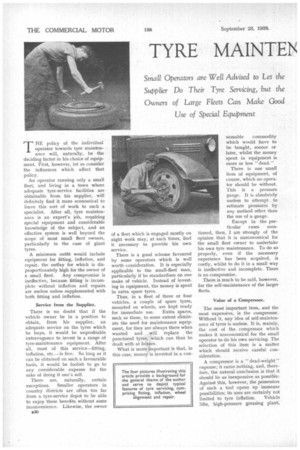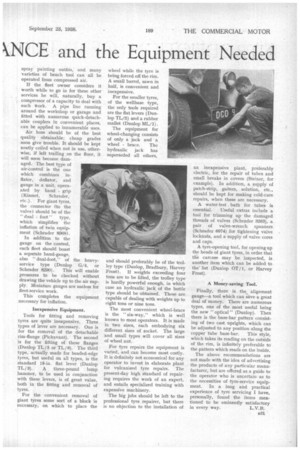TYRE MAINTEIN NCE and the Equipment Needed
Page 64

Page 65

If you've noticed an error in this article please click here to report it so we can fix it.
Small Operators are Well Advised to Let the Supplier Do Their Tyre Servicing, but the Owners of Large Fleets Can Make Good Use of Special Equipment
T_ HE policy of the individual operator towards tyre maintenance will, naturally, be the deciding factor in his choice of equipment. First, however, let us consider the influences which affect that policy.
An operator running only a small fleet, and. living in a town where adequate tyre-service facilities are obtainable from his supplier, will definitely find it more economical to leave this sort of work to such a specialist. After all, tyre maintenance is an expert's job, requiring special equipment and considerable knowledge of the subject, and an effective system is well beyond the scope of most small fleet owners, particularly in the case of giant tyres.
A minimum outfit would include equipment for fitting, inflation, and repair, the outlay for which is disproportionately high for the owner of a small fleet. Any compromise is ineffective, because fitting is incomplete without inflation ana repairs are useless unless supplemented with both fitting and inflation.
Service from the Supplier.
There is no doubt that if the vehicle owner be in a position to obtain, from his supplier, an adequate service on the tyres which he buys, it would be unprofitable extravagance to invest in a range of tyre-maintenance equipment. After all, most of this service—fitting, inflation, etc.—is free. So long as it can be obtained on such a favourable basis, it would be foolish to go to any considerable expense for the sake of doing it one's self.
There are, naturally, certain exceptions. Smaller operators in country districts are often too far from a tyre-service depot to be able to enjoy these benefits without some inconvenience. Likewise, the owner B30 of a fleet which is engaged mostly on night work may, at such times, find it necessary to provide his own service.
There is a good scheme favoured by some operators which is well worth consideration. It is especially applicable to the small-fleet man, particularly if he standardizes on one make of vehicle. Instead of investing in equipment, the money is spent in extra spare tyres.
Thus, in a fleet of three or four vehicles, a couple of spare tyres, mounted on wheels, are kept ready
for immediate use. Extra spares, such as these, to some extent eliminate the need for maintenance equipment, for they are always there when wanted and will replace the punctured tyres, which can thus be dealt with at leisure.
What is more important is that, in this case, money is invested in a con
sumable commodity which would have to be bought, sooner or later, whilst the money spent in equipment is more or less "dead."
There is one small item of equipment, of course, which no operator should be without. This is a pressure gauge. It is absolutely useless to attempt to estimate pressures by any method other than the use of a gauge.
Except in the particular cases mentioned, then, I am strongly of the opinion that it is uneconomical for the small fleet owner to undertake his own tyre maintenance. To do so properly, even if the necessary experience has been acquired, is costly, whilst to do it in a small way is ineffective and incomplete. There is no compromise.
There is much to be said, however, for the self-maintenance of the larger fleets.
Value of a Compressor.
The most important item, and the most expensive, is the compressor. Without it, any idea of self-maintenance of tyres is useless. It is, mainly, the cost of the compressor which makes it uneconomical for the small operator to do his own servicing. The selection of this item is a matter which should receive careful consideration.
A compressor is a " dead-weight " expense; it earns nothing, and, therefore, the natural conclusion is that it should be as inexpensive as possible: Against this, however, the possession of such a tool opens up immense possibilities; its uses are certainly not limited to tyre inflation. Vehicle lifts, high-pressure greasing plant, spray painting outfits, and many varieties of bench tool can all be operated from compressed air.
If the fleet owner considers it worth while to go in for these other services he will, naturally, buy a compressor of a capacity to deal with such *ark. A pipe line running around the workshop or garage and fitted with numerous quick-detachable couplers in convenient places, can be applied to innumerable uses.
Air hose should be of the best quality obtainable; cheap grades soon give trouble. It should be kept neatly coiled when not in use, otherwise, if left trailing on the floor, it Will soon become damaged. The best type of air-control is the one which combines inflator, deflator, and gauge in a unit, operaated by hand grip (Kismet, Schrader, etc.). For giant tyres, the connector (to the valve) should be of the " dual foot" type, which simplifies the inflation of twin equipment (Schrader 8968).
In addition to the gauge on the control, each fleet should boast a separate hand-gauge, also "dual-foot," of the heavyservice type (Dunlop G/4, or Schrader 8290). This will enable pressures to be checked without drawing the vehicle up to the air supply. Miniature gauges are useless for fleet-service work.
This completes the equipment necessary for inflation.
Inexpensive Equipment.
Tools for fitting and removing tyres are quite inexpensive. Three types of lever are necessary. One is for the removal of the detachable rim-flange (Pickavant). The second is for the fitting of these flanges (Dunlop TL /5 or TL/ 6). The third type, actually made for beaded-edge tyres, but useful on all types, is the standard 18-in, flat lever (Dunlop
TL/ 3). A three-pound lump hammer, to be used in conjunction with these levers, is of great value, both in the fitting and removal of tyres.
For the convenient removal of giant tyres some sort of a block is necessary, on. which to place the wheel while the tyre is being forced oil the rim. A small barrel, sawn in half, is convenient and inexpensive.
For the smaller tyres, of the wellbase type, the only tools required are the flat levers (Dunlop TL/3) and a rubber mallet (Dunlop ML/1).
The equipment for wheel-changing consists of only a jack and a wheel brace. The hydraulic jack has superseded all others, and should preferably be of the trolley type (Dunlop, Bradbury, Harvey Frost). If weights exceeding four tons are to be lifted, the trolley type is hardly powerful enough, in which case an hydraulic jack of the bottle type should be obtained. These are capable of dealing with weights up to eight tons or nine tons.
The most convenient wheel-brace is the "six-way," which is well known to most operators. It is made in two sizes, each embodying six different sizes of socket. The large and small types will cover all sizes of wheel nut.
For tyre repairs the equipment is varied, and can become most costly. It is definitely not economical for any operator to invest in elaborate plant for vulcanized tyre repairs. The present-day high standard of repairing requires the work of an expert, and entails specialized training with expensive machinery.
The big jobs should be left to the professional tyre repairer, but there is no objection to the installation of an inexpensive plant, preferably electric, for the repair of tubes and small breaks in covers (Steiner, for example). In addition, a supply of patch-strip, gaiters, solution, etc., should be kept for making cold-cure repairs, when these are necessary.
A water-test bath for tubes is essential. Useful extras include a tool for trimming up • the damaged threads of valves (Schrader 3263), a pair of valve-wrench spanners (Schrader 6974) for tightening valve locknuts, and a supply of valve cores and caps.
A tyre-opening tool, for opening up the beads of giant tyres, in order that the carcase may be inspected, is another item which can be added to the' list (Dunlop OT/ 1, or Harvey Frost).
A Money-saving Tool.
Finally, there is the alignment gauge—a tool which can save a great deal of money. There are numerous types, one of the most useful being the new " optical " (Dunlop). Then there is the base-bar pattern consisting of two cast uprights, which can be adjusted to any position along the copper tube base-bar. This style, which takes its reading on the outside of the rim, is infinitely preferable to the pattern which reads on the inside.
The above recommendations are not made with the idea of advertising the products of any particular manufacturer, but are offered as a guide to the operator who is uncertain as to the necessities of tyre-service equipment. In a long and practical experience of tyre servicing I have, personally, found the items mentioned to be eminently satisfactory in every way. L.V.B.












































































































































